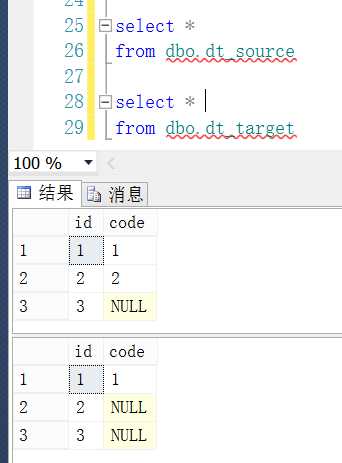标签:
NULL表示unknown,不确定值,所以任何值(包括null值)和NULL值比较都是不可知的,在on子句,where子句,Merge或case的when子句中,任何值和null比较的结果都是false,这就是NULL设下的陷阱,我被坑过。
有一次,我使用Merge同步数据,由于target表中存在null值,虽然在source表中对null值做过处理,但是忽略了target表中的null值,导致数据merge失败。
step1,创建示例数据
--create source table create table dbo.dt_source ( id int null, code int null ) on [primary] with(data_compression=page) --create target table create table dbo.dt_target ( id int null, code int null ) on [primary] with(data_compression=page)
step2,插入示例数据
示例数据中,Source表和Target表中都存在null值,不管是在Source表,还是在Target表,都要避免和null值进行比较。
--insert data into table insert into dbo.dt_source(id,code) values(1,1),(2,2),(3,null) insert into dbo.dt_target(id,code) values(1,1),(2,null)
step3,错误写法:只处理Source表中的null,而忽略Target表中的null
-- -1 stand for unknwon value merge dbo.dt_target t using dbo.dt_source s on t.id=s.id when matched and( t.code<>isnull(s.code,-1)) then update set t.code=s.code when not matched then insert(id,code) values(s.id,s.code);
查看Target和Srouce表中的数据,数据不同步,不同步的原因是when matched子句之后的and 条件, t.code中存在null值,null值和任何值(包括null值)比较的结果都是unknown,在when子句中视为false。

正确写法1,不管是在target表,还是在source表,只要存在null值,必须进行处理,避免出现和null进行比较的情况。
处理的方式是使用一个值来表示unknwon,如果ID列有效值不可能是负值,那么可以使用-1来代替unknown。因为-1和-1 是相等的,逻辑上就将null值和null值视为相同。
-- -1 stand for unknwon value merge dbo.dt_target t using dbo.dt_source s on t.id=s.id when matched and( isnull(t.code,-1)<>isnull(s.code,-1)) then update set t.code=s.code when not matched then insert(id,code) values(s.id,s.code);
正确写法2,在条件子句中,使用is null或 is not null来处理null值。
Tsql 使用is null和is not null来确实是,不是 null。 null is null 的逻辑值是true,other_value is null 为false, other_value is not null 为true。
merge dbo.dt_target t using dbo.dt_source s on t.id=s.id when matched and( t.code<>s.code or t.code is null or s.code is null) then update set t.code=s.code when not matched then insert(id,code) values(s.id,s.code);
标签:
原文地址:http://www.cnblogs.com/ljhdo/p/4979075.html